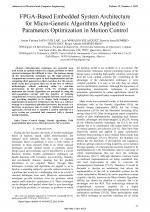| 1/2015 - 4 |
| Extra paper information in |
| Click to see author's profile in |
| Download PDF |
Author keywords
control design, genetic algorithms, field programmable gate arrays, microprocessors, servo systems
References keywords
genetic(22), algorithm(17), optimization(12), systems(9), design(8), controller(8), control(8), applications(7), system(6), implementation(6)
Blue keywords are present in both the references section and the paper title.
About this article
Date of Publication: 2015-02-28
Volume 15, Issue 1, Year 2015, On page(s): 23 - 32
ISSN: 1582-7445, e-ISSN: 1844-7600
Digital Object Identifier: 10.4316/AECE.2015.01004
Web of Science Accession Number: 000352158600004
SCOPUS ID: 84924804553
Abstract
Meta-heuristic techniques are powerful tools used to find an optimal solution for complex problems to which classical techniques find difficult to solve. The features among all the meta-heuristic techniques are the high amount of computational resources spent on their implementation and the computing effort generated on their execution. For this reason, many works have proposed their use on the base of software methodologies without achieving online or real-time performance. In the present work, two strategies that implement the Genetic Algorithms are presented by using the micro-population concept with the objective of reducing computational resources, increasing the heuristic search speed, and providing simplicity in its design. Both strategies are implemented in hardware architecture; the first, as a software strategy in a proprietary embedded processor, the second, as a hardware co-processor unit. In order to validate the proposed approaches, several tests to optimize a motion controller in a servo system are presented and compared with a classical tuning technique. |
| References | | | Cited By |
Web of Science® Times Cited: 3 [View]
View record in Web of Science® [View]
View Related Records® [View]
Updated today
SCOPUS® Times Cited: 3
View record in SCOPUS® [Free preview]
View citations in SCOPUS® [Free preview]
[1] A Computationally Efficient Pipelined Architecture for 1D/2D Lifting Based Forward and Inverse Discrete Wavelet Transform for CDF 5/3 Filter, CEKLI, S., Advances in Electrical and Computer Engineering, ISSN 1582-7445, Issue 2, Volume 18, 2018.
Digital Object Identifier: 10.4316/AECE.2018.02003 [CrossRef] [Full text]
[2] Micro-genetic algorithms for detecting and classifying electric power disturbances, Jaen-Cuellar, Arturo Yosimar, Morales-Velazquez, Luis, Romero-Troncoso, Rene de Jesus, Moriñigo-Sotelo, Daniel, Osornio-Rios, Roque Alfredo, Neural Computing and Applications, ISSN 0941-0643, Issue S1, Volume 28, 2017.
Digital Object Identifier: 10.1007/s00521-016-2355-z [CrossRef]
[3] Centroid Update Approach to K-Means Clustering, BORLEA, I.-D., PRECUP, R.-E., DRAGAN, F., BORLEA, A.-B., Advances in Electrical and Computer Engineering, ISSN 1582-7445, Issue 4, Volume 17, 2017.
Digital Object Identifier: 10.4316/AECE.2017.04001 [CrossRef] [Full text]
Disclaimer: All information displayed above was retrieved by using remote connections to respective databases. For the best user experience, we update all data by using background processes, and use caches in order to reduce the load on the servers we retrieve the information from. As we have no control on the availability of the database servers and sometimes the Internet connectivity may be affected, we do not guarantee the information is correct or complete. For the most accurate data, please always consult the database sites directly. Some external links require authentication or an institutional subscription.
Web of Science® is a registered trademark of Clarivate Analytics, Scopus® is a registered trademark of Elsevier B.V., other product names, company names, brand names, trademarks and logos are the property of their respective owners.
Faculty of Electrical Engineering and Computer Science
Stefan cel Mare University of Suceava, Romania
All rights reserved: Advances in Electrical and Computer Engineering is a registered trademark of the Stefan cel Mare University of Suceava. No part of this publication may be reproduced, stored in a retrieval system, photocopied, recorded or archived, without the written permission from the Editor. When authors submit their papers for publication, they agree that the copyright for their article be transferred to the Faculty of Electrical Engineering and Computer Science, Stefan cel Mare University of Suceava, Romania, if and only if the articles are accepted for publication. The copyright covers the exclusive rights to reproduce and distribute the article, including reprints and translations.
Permission for other use: The copyright owner's consent does not extend to copying for general distribution, for promotion, for creating new works, or for resale. Specific written permission must be obtained from the Editor for such copying. Direct linking to files hosted on this website is strictly prohibited.
Disclaimer: Whilst every effort is made by the publishers and editorial board to see that no inaccurate or misleading data, opinions or statements appear in this journal, they wish to make it clear that all information and opinions formulated in the articles, as well as linguistic accuracy, are the sole responsibility of the author.



